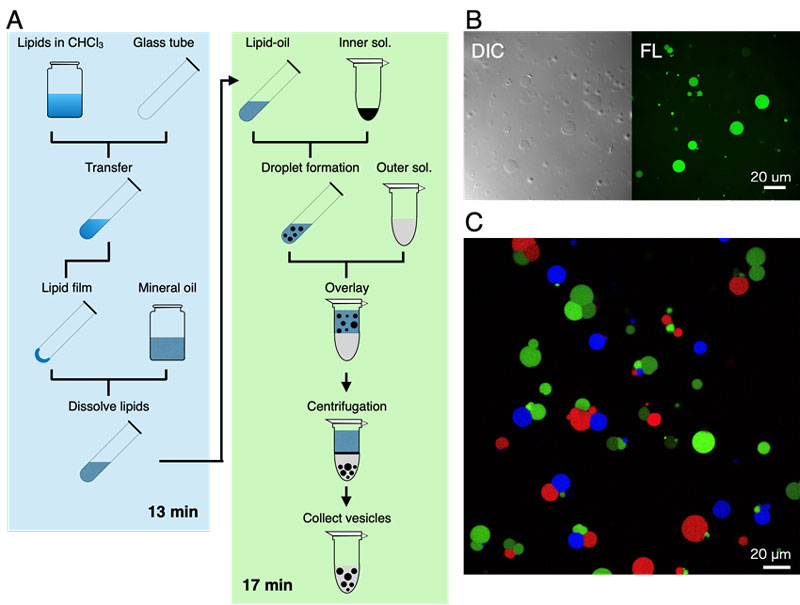Dr. Yutetsu Kuruma and Yasuhiro Shimane, researchers at Japan Agency for Marine-Earth Science and Technology (JAMSTEC), have established a rapid and easy method to prepare artificial cells through optimizing a process using the droplet transfer method. Artificial cell research attempts to fabricate cell-like entities from molecules and genes to apply as next-generation bioengineering or to elucidate the mystery of how cellular life emerged in the early earth environment. Artificial cells are generally constructed by encapsulating a cell-free gene expression system (cell-free system)(1) inside vesicles consisting of a phospholipid membrane, where several cellular functions can be reproduced inside. To do this, the formation of membrane vesicles in the laboratory at the same size scale as actual cells is the most important consideration. Although the general protocol of vesicle preparation has been shared, it is often difficult to form quality vesicles, especially for students or researchers who are non-experts of this field or technique. Since the bottom-up construction of cells is becoming a global trend in the field of synthetic biology, it is important to reduce technical barriers and increase the research population for the development of this research field.

Figure 1: Quick and easy preparation of artificial cells. (A) Droplet transfer method simplified for encapsulating a cell-free system. The left half shows the steps for dissolving lipid in oil (lipid-oil) and the right half shows the steps for membrane vesicle formation. (B) Confocal microscopy images of the artificial cells prepared by this method. Green fluorescent protein (GFP) was synthesized from the gene inside vesicles. (C) A confocal microscopy image of artificial cells expressing different colors of fluorescent proteins. DIC: differential interference contrast. FL: fluorescent image. Scale bar: 20 µm.
To assist these students and researchers, Kuruma and Shimane succeeded in simplifying the steps of vesicle preparation while also shortening the preparation time which improved throughput. Specifically, preparation of the lipid-dissolving oil is a key step in vesicle construction, and the temperature and dissolution time was optimized in this study to improve this key step. The refined method allows formation of artificial cells within 30 minutes whereas a conventional method takes hours to a day, and the synthesis of fluorescent proteins (which shows the ability for an artificial cell to produce a protein product) by the encapsulated cell-free system, also called the PURE system. Additional optimization of the procedure, including lyophilization (or freeze-drying) of the premixture of the PURE system, allows artificial cell formation within only 20 minutes. This new optimized preparation technique enables researchers to work with artificial cells outside of the traditional laboratory due to the ease of production. The researchers are currently developing an artificial cell kit that is formatted as a “ready-to-use” kit for quick and easy production of artificial cells even for students or non-experts.
This research was led by Dr. Yutetsu Kuruma, a principal investigator of the project “Construction of artificial cells composed of a minimal genome” in the research area “Large-scale genome and cell programming” under the JST’s Strategic Basic Research Programs PRESTO (JPMJPR18K5), as well as the project “Stable propagation of a minimal synthetic cell” supported by a research grant from the Human Frontier Science Program (RGP0029/2020).
(1) A cell-free gene expression system
A reaction solution containing all factors necessary for RNA transcription from DNA encoding genes of interest and translation into proteins outside of a biological cell. The present study used the reconstituted PURE system (Shimizu et al. Nat Biotechnol. 2001), which is composed of purified proteins and small molecular compounds such as RNA, amino acids, etc. This system was originally developed by Yoshihiro Shimizu (RIKEN), and its commercially available kit (GeneFrontier, Japan) was used in this study.
|
HFSP award information Research Grant - Program (RGP0029/2020): Stable propagation of a minimal synthetic cell Principal investigator: Yutetsu Kuruma, X-Start, Japan Agency for Marine-Earth Science and Technology, Kanagawa, Japan |
|
Other funding Japan Science and Technology Agency (JST) PRESTO (JPMJPR18K5) Principal Investigator: Yutetsu Kuruma, X-Start, Japan Agency for Marine-Earth Science and Technology, Kanagawa, Japan |


































